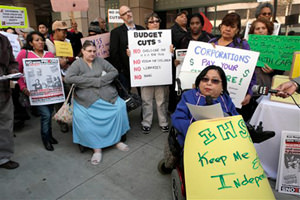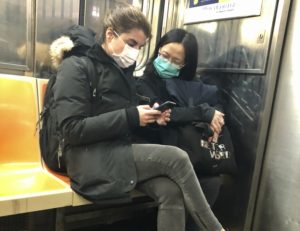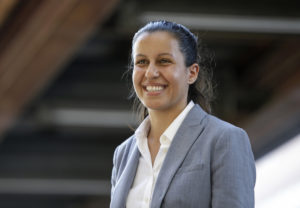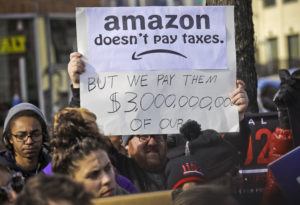State Budget Cuts Are Bad for Your Health
The budget cuts being proposed in state capitals around the country may sound vague and abstract, but what they boil down to are many scenes of misery.
The budget cuts being proposed in state capitals around the country may sound vague and abstract, but what they boil down to are many scenes of misery. Picture, for example, an asthmatic kid waiting several hours in an emergency ward for treatment that will allow her to resume normal breathing.
Think of that child. How will she do in school if she’s constantly struggling to take a breath? And think of her school, hard hit with budget cuts that make class sizes larger while reducing the number of school days. These reductions will also hurt the college she will need to attend to prepare for a decent job.
This—and worse—shouldn’t happen in the United States. But it will, judging from last week’s reports of huge budget cuts in 31 states caused by the recession and the end of federal economic stimulus aid. Despite big deficits, only a few states are considering raising taxes or extending previous tax increases. Only one governor, in Nebraska, has proposed using reserve funds to ease the pain.
The reports were compiled by the Center on Budget and Policy Priorities, which concluded: “Cutting state services not only harms vulnerable residents but also slows the economy’s recovery from recession by reducing overall economic activity. When states cut spending, they lay off employees, cancel contracts with vendors, reduce payments to businesses and nonprofits that provide services, and cut benefit payments to individuals.”
To find out what this will mean, I called Jim Mangia, president of St. John’s Well Child and Family Center in South Los Angeles. I’d visited St. John’s last year. At that time, there was a line, extending a block or more, of patients waiting for the center to open at 8 a.m. The caseload has grown since then, Mangia told me.
The center provides services for about 40,000 in a large area where most of the residents are working-class Latinos and African-Americans. The neighborhood is filled with the unemployed and uninsured. Government aid through Medi-Cal (known as Medicaid in other states) provides for much of the care at St. John’s. Since Medicaid is financed with federal, state and local funds, the state reductions will hurt these people badly.
One of the worst of Democratic Gov. Jerry Brown’s proposed cutbacks would limit the patients to 10 doctor visits a year.
“What happens to a patient on dialysis?” said Mangia. “With this budget they are making a decision that some people will die who don’t have to die. What happens to a kid with asthma who is over his 10 visits? Will they let him die?”
Actually, the child could be taken to one of the few county emergency hospitals, where the wait is usually six hours and sometimes much more. It’s the same with a person on dialysis.
But here’s the catch: Visits to these emergency hospitals cost the taxpayers more than treatment in community centers like St. John’s or at home. St. John’s manages cases so that patients avoid the hospital. Diabetics, for example, learn about diet and exercise.
Another cut that would actually cost more in the long run is the reduction in funds for adult day care. I’ve visited centers where this care is provided. Old people suffering from dementia and other ailments spend the day in a supportive, friendly atmosphere, watched by volunteers and professionals. The centers provide relief for spouses, children and other caregivers. And they keep the ill out of nursing homes, too many of which are substandard and poorly supervised, although expensive.
Money for other programs designed to encourage home care would also be cut, including payments for home health workers and purchase of incontinence supplies and other medical equipment.
In Texas, the Houston Chronicle commented, cuts in pay to home health workers would mean the frail would no longer get help “with things like shopping, tracking medicines or bathing. The elderly who outlive their assets—the blind, the Alzheimer’s-addled, the wheelchair-bound—would be left to shift for themselves.”
The other area targeted for big cuts is education. Democratic Gov. Andrew Cuomo proposes a $1.5 billion, or 7.3 percent, cut to New York’s education aid. California’s Brown proposes cutting $1 billion from the University of California and state university systems, as well as taking money from the two-year community colleges.
America’s domestic big three—health, education and jobs—are intertwined. The short-range state cuts in health and education will have a damaging long-range impact on employment, our biggest domestic problem.
As the Center on Budget and Policy Priorities said, “Research shows that in order to prosper, businesses require a well-educated, healthy workforce. Many of the state budget cuts described here will weaken that workforce in the future by diminishing the quality of elementary and high schools, making college less affordable, and reducing residents’ access to health care. In the long term, the savings from today’s cuts may cost states much more in diminished economic growth.”
The United States, however, seems to have reached a bipartisan consensus to reject this far-seeing thinking. From right-wing Republican Gov. Haley Barbour in Mississippi to Democrats Brown and Cuomo, state governments, cheered on by Washington, have embarked on a race to the bottom.
Your support matters…Independent journalism is under threat and overshadowed by heavily funded mainstream media.
You can help level the playing field. Become a member.
Your tax-deductible contribution keeps us digging beneath the headlines to give you thought-provoking, investigative reporting and analysis that unearths what's really happening- without compromise.
Give today to support our courageous, independent journalists.







You need to be a supporter to comment.
There are currently no responses to this article.
Be the first to respond.